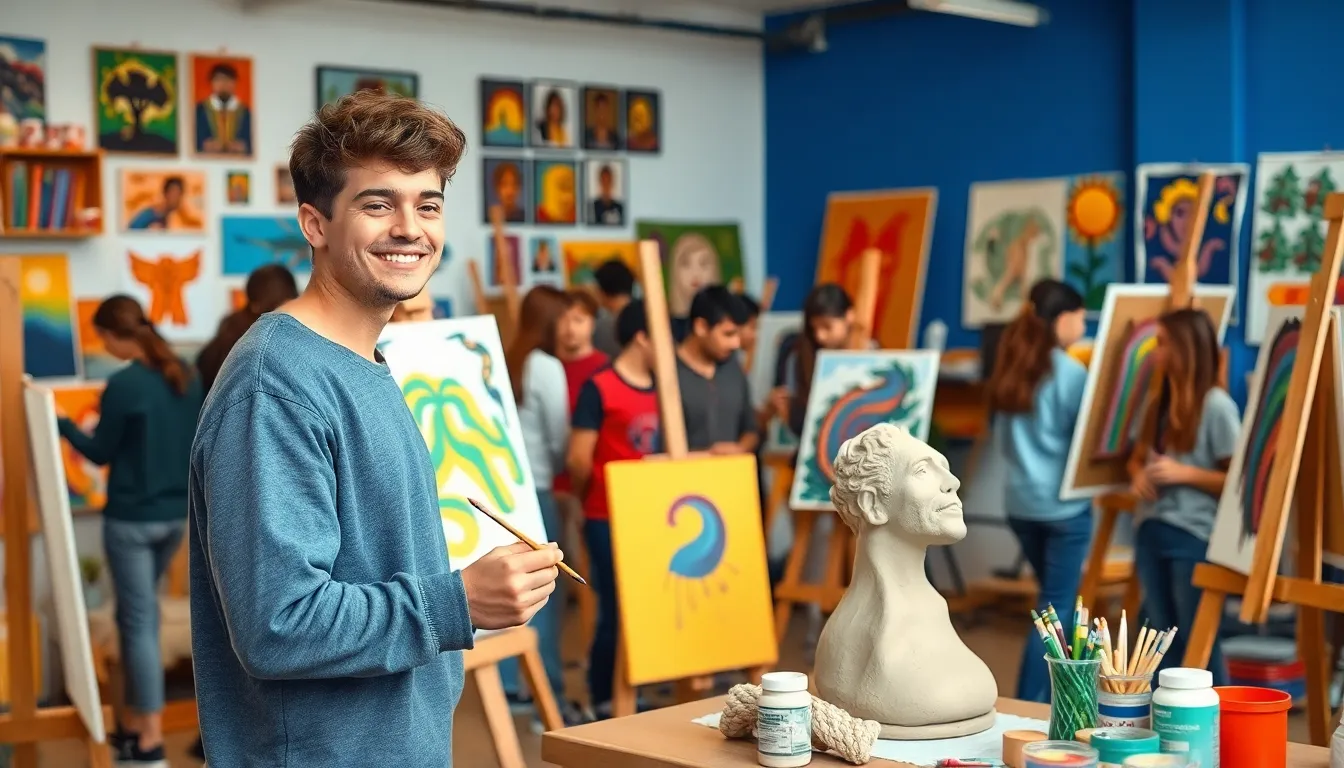Table of Contents
ToggleIn a world where TikTok dances reign supreme, it’s easy to overlook the magic of creativity. Yet, teen art classes are the unsung heroes of self-expression. They offer more than just paint and canvas; they provide a safe space for young people to explore their imagination, make mistakes, and maybe even discover their inner Picasso—or at least a slightly less famous version.
Overview Of Teen Art Classes
Teen art classes offer structured environments for creativity and self-discovery. Various mediums, including painting, drawing, and sculpture, are commonly explored in these classes. Classes often cater to diverse skill levels, allowing both beginners and experienced young artists to grow.
Students develop artistic techniques while receiving guidance from skilled instructors. Feedback from peers and teachers fosters growth in technical skills and boosts confidence. Each session encourages experimentation with different styles and approaches, enriching the overall artistic experience.
Art classes provide opportunities to participate in collaborative projects. Working together can help students build friendships and enhance teamwork skills. Utilizing various materials, they learn to express emotions and thoughts, further deepening their creative journey.
Additionally, educational outings often complement regular classes. Workshops, exhibitions, and field trips expose students to diverse artistic perspectives. These experiences may spark new interests and broaden their understanding of the art world.
Incorporating modern technology, some programs integrate digital art lessons. Teenagers can explore graphic design, animation, and photography. This expansion into digital forms equips them with relevant skills for future artistic endeavors.
Local art programs frequently offer scholarships for talented young individuals. Financial assistance ensures that all interested teens have access to artistic education, promoting inclusivity. With a focus on building artistic identity, teen art classes nurture self-expression and innovation.
Benefits Of Teen Art Classes

Teen art classes offer unique advantages for young people seeking self-expression and creativity. These classes nurture talents, allowing teenagers to explore their artistic potential in a supportive environment.
Creative Expression
Creative expression flourishes in art classes, where students experiment with various mediums. Painting, drawing, and sculpture become outlets for their thoughts and feelings. Opportunities to share artwork during class enhance communication skills and foster a sense of community. Many teens discover their voice through visual art, gaining confidence as they express their unique perspectives. Constructive critique from peers and instructors encourages further exploration of ideas and styles. Each project provides a chance to convey emotions, building a deeper connection with their artistic journey.
Skill Development
Skill development forms a core component of teen art classes. Instructors guide students in mastering techniques tailored to their skill levels, from basic drawing to advanced painting. Structured lessons focus on elements like composition and color theory, helping young artists refine their abilities. Regular practice leads to improved technical skills and greater artistic flexibility. Exposure to different styles makes students more versatile artists. Collaboration on group projects enhances teamwork skills alongside artistic growth. Ultimately, these classes equip teens with valuable skills beneficial for future opportunities in various creative fields.
Types Of Teen Art Classes
Teen art classes encompass a variety of formats, each offering unique learning opportunities. Understanding these options can help students choose classes that align with their interests.
Traditional Art Classes
Traditional art classes focus on fundamental techniques in mediums like painting, drawing, and sculpture. Students learn skills such as color theory, composition, and perspective through hands-on projects. Instructors provide personalized feedback, helping students refine their artistic abilities. Workshops often facilitate exploration of various styles, enhancing creativity. Classes cater to all skill levels, so beginners and advanced artists thrive in these supportive environments.
Digital Art Classes
Digital art classes introduce students to modern artistic techniques, utilizing technology to create art. Young artists explore graphic design, photography, and animation, gaining exposure to industry-standard software. Instructors teach essential skills such as digital painting and photo editing, fostering creativity in a digital space. Collaboration on projects allows students to share ideas and build community. These classes prepare teens for potential careers in digital media, expanding their artistic horizons.
Specialty Workshops
Specialty workshops focus on niche areas of art, such as printmaking, sculpture, or mixed media. These classes provide opportunities for deeper learning in specific techniques. Led by experts in their fields, instructors guide students through intricate processes, allowing for hands-on experimentation. Teens engage in collaborative projects, enhancing teamwork skills while fostering friendships. Workshops often culminate in a final project, giving students a chance to showcase their unique styles and creativity.
Finding The Right Teen Art Class
Identifying the perfect teen art class involves several factors to consider. Availability often plays a significant role in selecting classes that fit into schedules.
Local Community Centers
Community centers frequently offer diverse teen art classes designed for different skill levels. Locations might provide painting, drawing, and sculpture options, encouraging students to explore various mediums. Many centers maintain affordable rates, promoting accessibility for all teens interested in art. Enrolling in classes at these venues often allows for personalized instruction from local artists, fostering a supportive atmosphere. Opportunities for collaboration abound through group projects and exhibitions, connecting teens with peers sharing similar interests in creativity.
Online Platforms
Online platforms provide flexibility and convenience for teens interested in art classes. Numerous websites offer virtual workshops, allowing students to learn at their own pace from home. Access to a variety of art styles, techniques, and mediums enables young artists to explore their unique creative expressions. Interactive sessions with instructors often enhance the learning experience, even in a virtual environment. Additionally, many platforms feature community forums that encourage students to share their work and receive constructive feedback, building a sense of connection among budding artists.
Teen art classes play a crucial role in nurturing creativity and self-expression among young individuals. By providing a supportive environment, these classes empower students to explore their artistic potential and develop essential skills. The diverse range of mediums and techniques available ensures that every teen can find a class that resonates with their interests.
Through collaboration and constructive feedback, students not only enhance their artistic abilities but also build lasting friendships. Engaging with experienced instructors and participating in workshops further enriches their artistic journey. As teens embrace their creativity, they gain confidence and valuable skills that can open doors to future opportunities in the arts. Investing in teen art classes is a step towards fostering a generation of innovative and expressive artists.





